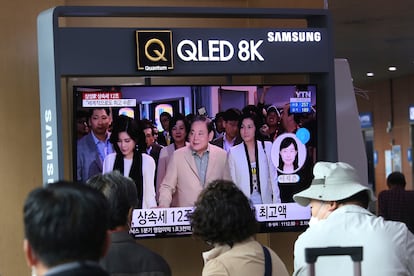Picasso works.
From Miró.
Family of marsupial centaurs
, by Dalí.
Le bassin aux nymphéas
, by Claude Monet;
Les Amoureux aux Bouquets Rouges
, by Marc Chagall ... These are some of the 23,000 pieces of art and antiques that the heirs of the South Korean conglomerate Samsung are going to donate to museums in their country, after the death in October of Lee Kun-hee, patriarch of the clan and founder of the largest business empire in the country.
More information
New conviction for corruption, of two and a half years in prison, for the Samsung heir
The heirs of the president of Samsung will pay almost 9,000 million euros for the inheritance tax
In a statement issued Wednesday, Lee's family said they will pay the sum of about 12 trillion South Korean won (about 8.9 billion euros) in inheritance taxes.
It is the highest amount paid in the country's history for that concept: South Korean laws tax large inheritances by up to more than 50% and the personal fortune of the founder of Samsung, the richest man in South Korea, is estimated to be around 20 trillion won.
Most of the artwork will be donated to two museums. The National Museum of Korea will receive 21,600 pieces, mostly antiquities and cultural relics, including some 60 pieces listed as national treasures by the Government in Seoul. In addition, the Museum of Modern and Contemporary Art (MMCA), which has four locations in the country, will receive more than 1,600 works by modern masters, both Korean - names such as Park Soo-Keun or Chang Ucchin - and international. Other works will go to smaller museums, specializing in certain South Korean artists.
The donation will help amplify the international impact of the MMCA, which until now had concentrated its collection on national artists and did not have any work by foreign masters, such as Picasso or Monet.
The center plans to organize an exhibition in the second half of the year with part of the pieces received, the largest private gift in its history.
The value of the works given to museums can add up, according to the South Korean news agency Yonhap, about two trillion won (almost 1.5 billion euros).
It does not include pieces by artists such as Francis Bacon, Alberto Giacometti or Mark Rothko, which are exhibited at the Leeum Museum - owned by the Samsung foundation - in Seoul and which South Korean media had conjectured could be included in the operation.
Several people watch archival footage of Samsung owner Lee Kun-hee on television.Ahn Young-joon / AP
The Minister of Culture, Hwang Hee, has expressed in a press conference his "deep gratitude" to the Lee family for "enriching" the national cultural funds.
But he declined to answer whether the donation is in response to an attempt by Samsung to create a climate of benevolence around Lee Jae-yong, its vice president and only son of the late founder.
The 52-year-old, the person in charge of the conglomerate and electronics giant since his father's illness, has been in jail since January after being convicted of corruption charges.
Samsung has indicated in a statement: “We hope that the donation will contribute to preserving the national cultural heritage and to give a boost to the public's right to enjoy culture, as well as to research in the field of art history, since it does not there are precedents for a donation of this size ”. The group, which started as a vegetable trading company more than eighty years ago, is today the main company in South Korea, where its business accounts for more than 20% of the country's annual GDP.
The president of the South Korean Galleries Association, Huang Dal-seung, told the
Korea Herald
newspaper
:
“It is good news that Lee's valuable works of art are being donated to society and given to national museums. I find it a shame that some art museums dedicated to Korean masters do not have enough works by these artists. "
However, there have been voices critical of the distribution of the artistic legacy, such as that of Professor Choe Byong-suh, from Dongduk Women's University, who declared to the same medium: “It seems that the collection is going to be distributed among different entities throughout the country, which lowers its value. It would have been better to keep it whole in one place to display as Lee Kun-hee's collection. That would have attracted more attention and visitors, both national and foreign. "

